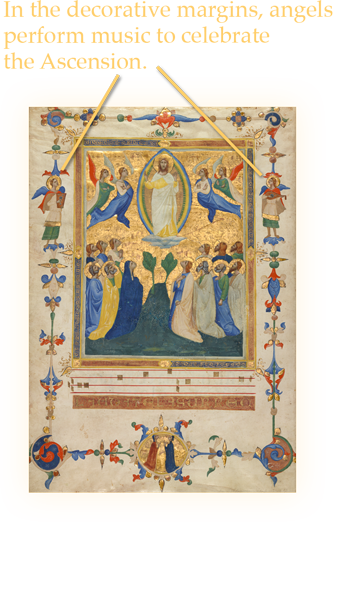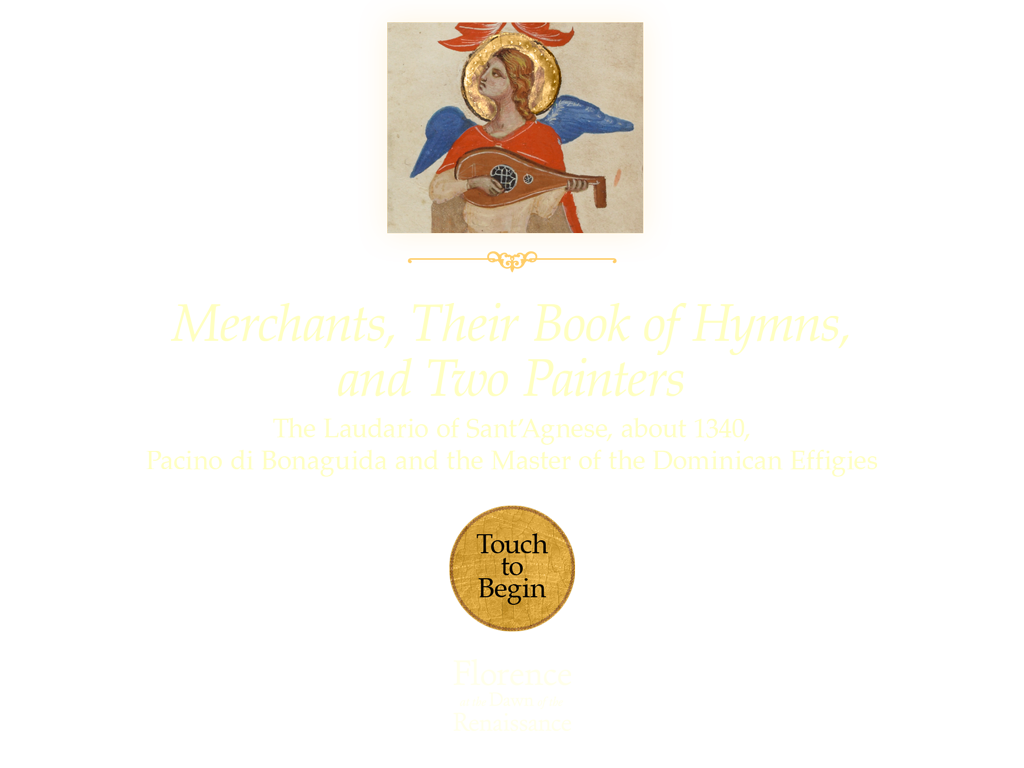
Book of Songs
The Ascension of Christ


The Ascension of Christ, a leaf from the Laudario of Sant'Agnese, depicts Christ's rise to heaven after his Resurrection. In the main illumination, artist Pacino di Bonaguida painted Christ into a mandorla (almond-shaped frame) and the apostles below in a landscape.
Because the laudario is a songbook, the page contains musical notation and depictions of angels playing instruments. Tiny figures in the lower margin represent the book's donors kneeling in prayer.






Book of Songs
Musical Praise


Music was a means by which medieval Christians expressed devotion to God. Consisting of laude—hymns of praise—a laudario was used by lay religious people to celebrate feast days in the liturgical calendar.
A lauda consisted of a simple melody sung by a soloist, followed by a choral refrain. Because it was sung in Italian it would have evoked the liveliness of secular music rather than the formal Latin chant of the mass.




Book of Songs
Instruments of Devotion


In the margins on either side of the main illustration, two angels play medieval musical instruments—a psaltery and a lute. These angels likely mirror the musicians who accompanied the lauda singers.




Saints' Days
Holy Role Models


Medieval Christians regarded saints as important role models and often appealed to them for help and spiritual guidance. Each holy man and woman was honored on a specific day of the year, when choirs sang songs praising them.
Although confraternities often used small, undecorated songbooks on a daily basis, larger illuminated books of hymns like the Laudario of Sant'Agnese were used by wealthier confraternities.

A Manuscript Reunited
Some Assembly Required


The Laudario of Sant'Agnese, illuminated by Pacino di Bonaguida and the Master of the Dominican Effigies, was probably taken apart in the early nineteenth century because of the high quality of its elaborate decoration. Twenty-eight leaves and fragments survived from the book into the twentieth century.
Reassembling the surviving leaves into their original configuration was determined in part by their folio numbers. These can be seen on at least fifteen of the leaves; the lowest is XI (11) and the highest is CXXI (121). We can only speculate how many additional pages have been lost.


A Manuscript Reunited
Clues to the Puzzle


Some of the leaves and fragments were pasted into collectors' albums or onto cardboard (to resemble panel paintings), obscuring the side of the leaf with the folio number.
Sometimes the illuminated portions of the page were cut out, cropping the folio numbers.



A Manuscript Reunited
The Finer Details


A team of Getty curators, conservators, and conservation scientists undertook a study of nine leaves from the Laudario of Sant'Agnese in order to learn more about the book's construction.
Looking closely at the leaves using scientific examination techniques revealed information about the book illuminators' working processes, contributing to a broader understanding of workshop practice and the nature of artistic collaboration in 1300s Florence.


Chorus of Merchants
The Compagnia di Sant'Agnese


Every evening the Compagnia di Sant'Agnese gathered in their chapel in Santa Maria del Carmine to sing. One can imagine their ornate laudario placed on a lectern decorated with a cloth and candles.
As one or two individuals sang the main verse, others, holding their own candles, would repeat the refrain.


Chorus of Merchants
Patrons in Prayer


Confraternities were made up of Florence's merchant class—shopkeepers, traders, artisans—who gathered to sing, perform charitable acts, arrange funerals for their members, and gain civic power through community affiliation. The fact that the Compagnia could commission a luxurious manuscript testifies to the rising wealth of the middle class.
Many of the Laudario's leaves and cuttings include images of Compagnia members as tiny figures nestled in the page designs.














